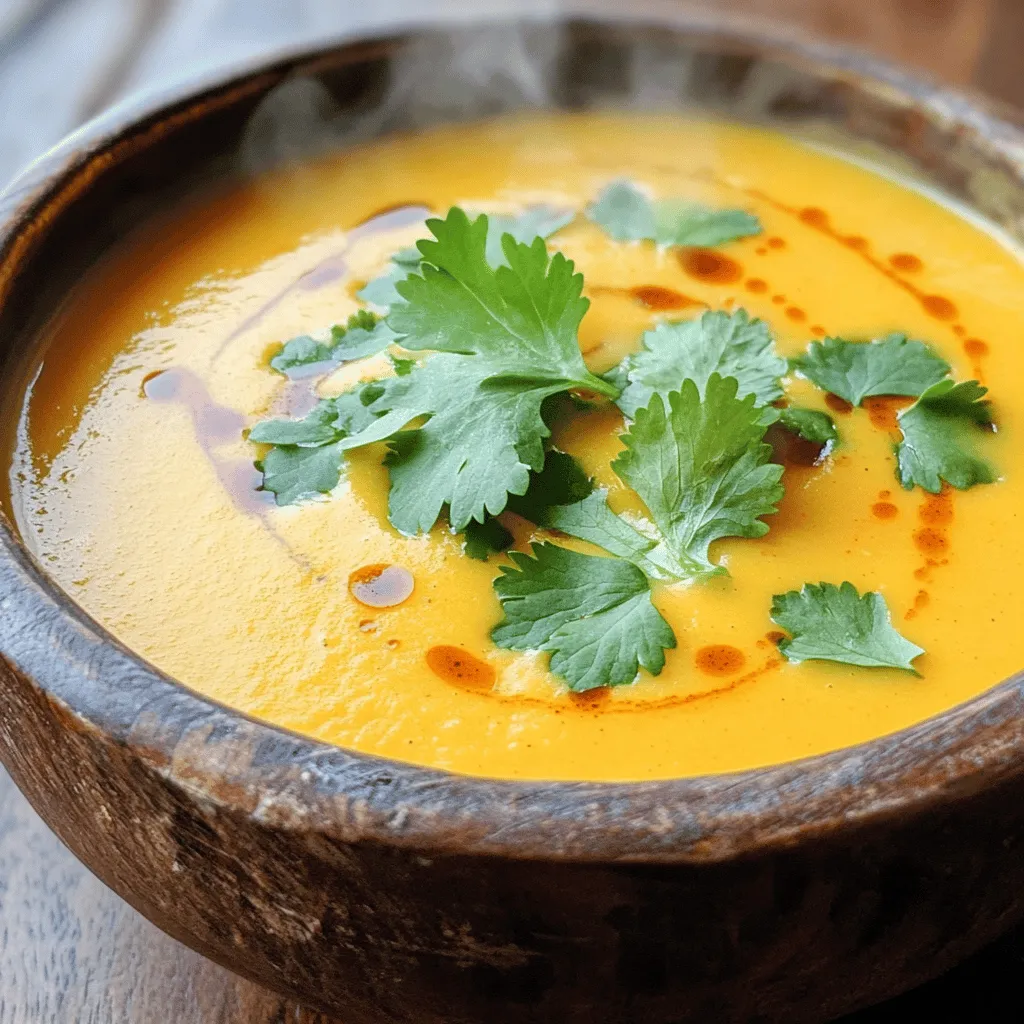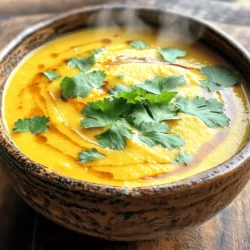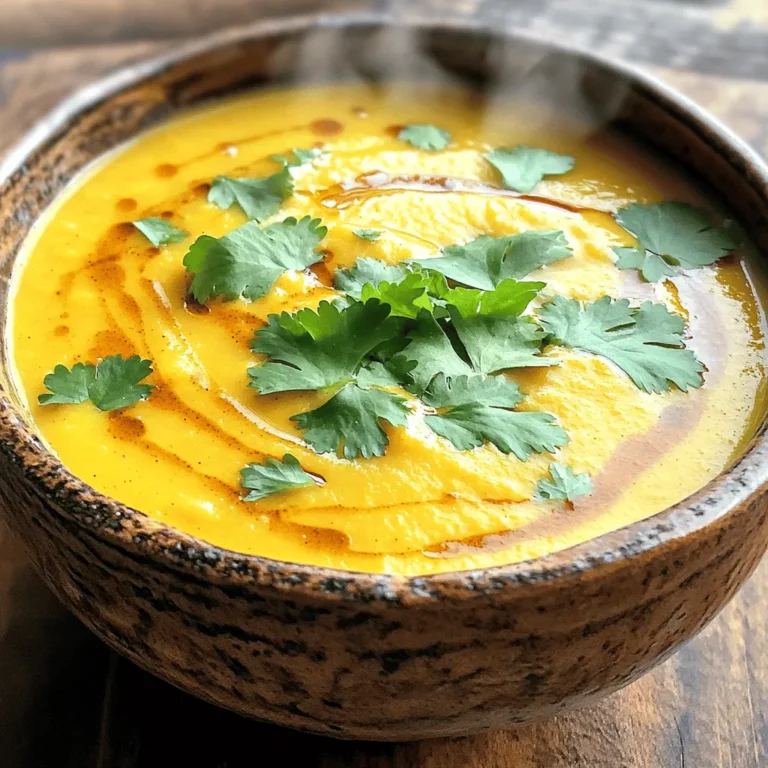Warm up your kitchen and your soul with my Coconut Curry Butternut Soup! This dish is the perfect mix of cozy comfort and vibrant flavors. Made with creamy coconut milk and sweet butternut squash, it’s a delicious blend to warm your heart. I will guide you through simple steps, ingredient swaps, and helpful tips to make this dish shine. Ready to create a big bowl of joy? Let’s dive into the recipe!
Ingredients
List of Ingredients
To make Coconut Curry Butternut Soup, you will need:
– 1 medium butternut squash, peeled and diced into 1-inch cubes
– 1 tablespoon olive oil
– 1 medium onion, finely chopped
– 3 cloves garlic, minced
– 1 tablespoon fresh ginger, grated or minced
– 2 tablespoons red curry paste (adjust based on spice preference)
– 4 cups vegetable broth (low-sodium recommended)
– 1 can (14 oz) coconut milk (full-fat for creaminess)
– 1 tablespoon maple syrup (optional, for a touch of sweetness)
– Salt and freshly ground black pepper, to taste
– Juice of 1 lime (about 2 tablespoons)
– Fresh cilantro leaves, for garnish
Ingredient Substitutions
You can swap ingredients based on what you have.
– Butternut squash can be replaced with sweet potatoes or pumpkin.
– Olive oil works well, but you can also use coconut oil for extra flavor.
– Red curry paste can be replaced with yellow curry paste for less heat.
– Vegetable broth can be switched with chicken broth for a different taste.
– Use light coconut milk if you want a lighter soup.
– Maple syrup is optional. You can use honey or agave instead.
Nutritional Benefits
Coconut Curry Butternut Soup offers many healthy benefits.
– Butternut squash is high in vitamins A and C.
– Coconut milk provides healthy fats, which are good for your heart.
– Ginger helps with digestion and adds a nice kick.
– Fresh cilantro is rich in antioxidants and adds freshness.
– This soup is a great source of fiber, keeping you full longer.
Enjoy this tasty, nutritious soup that warms the soul and delights the taste buds!
Step-by-Step Instructions
Preparing the Base (Heating Oil and Adding Aromatics)
Start by heating 1 tablespoon of olive oil in a large pot over medium heat. The oil needs to be hot but not smoking. Once hot, add 1 medium onion that you finely chopped. Sauté the onion for about 5 minutes. You want it to turn translucent and soften.
Next, stir in 3 minced garlic cloves and 1 tablespoon of grated ginger. Cook this mixture for another 1-2 minutes. Keep stirring to avoid burning the garlic. When it smells fragrant, you know it’s ready for the next step.
Incorporating Butternut Squash and Curry Paste
Now, add the diced butternut squash to the pot. Use a medium squash, peeled and cut into 1-inch cubes. Stir in 2 tablespoons of red curry paste. This gives the soup its spice and flavor. Make sure the squash is well coated with the curry paste.
Once mixed, pour in 4 cups of vegetable broth. I prefer low-sodium broth for better control of the soup’s saltiness. Bring this mixture to a boil. When boiling, reduce the heat to low. Cover the pot and let it simmer for 20-25 minutes. You want the squash to be tender when pierced with a fork.
Blending and Final Seasoning
After the squash is tender, take the pot off the heat. Use an immersion blender to blend the soup until it’s smooth and creamy. If you don’t have an immersion blender, carefully ladle the soup into a standard blender. Blend in batches and return it to the pot once smooth.
Now, put the pot back on low heat. Stir in a can of coconut milk for creaminess. If you like a touch of sweetness, add 1 tablespoon of maple syrup. Season with salt, black pepper, and the juice of 1 lime. This adds brightness to the soup. Taste and adjust as needed.
Let the soup warm on low heat for another 5 minutes. Stir occasionally to help the flavors meld together. Now, it’s ready to serve! Ladle it into bowls and top with fresh cilantro leaves for a burst of flavor and color. Enjoy your comforting bowl of Coconut Curry Butternut Soup!
Tips & Tricks
Common Mistakes to Avoid
When making Coconut Curry Butternut Soup, avoid these common errors:
– Not peeling the squash: The skin is tough and bitter. Always peel it first.
– Skipping the aromatics: Garlic and ginger add great flavor. Don’t skip them.
– Overcooking the squash: Cook until tender, but not mushy. It should hold its shape.
– Blending too quickly: If using a standard blender, let the soup cool slightly before blending. This prevents splatters.
Recommended Cooking Tools
Having the right tools makes cooking easier. Here’s what I recommend:
– Large pot: A sturdy pot helps cook the soup evenly.
– Immersion blender: This makes blending easy. It saves time and cleanup.
– Cutting board and knife: A sharp knife helps with chopping the squash and veggies.
– Measuring cups and spoons: Accurate measurements ensure the best flavor.
Enhancing Flavor and Texture
Want to take your soup to the next level? Try these tips:
– Use fresh herbs: Cilantro adds freshness. Add it just before serving.
– Add lime zest: It brightens the soup. Zest before juicing the lime.
– Experiment with spices: A pinch of cumin or turmeric adds depth. Adjust to your taste.
– For creaminess: Use full-fat coconut milk. It makes the soup rich and smooth.
– Add crunch: Top with roasted nuts or seeds for texture. They add a nice contrast to the creamy soup.
Enjoy these tips as you create your Coconut Curry Butternut Soup!

Variations
Vegan and Gluten-Free Options
This soup is already vegan and gluten-free! The key ingredients are all plant-based. You use butternut squash, coconut milk, and vegetable broth. These make a creamy base without any animal products. Just check your red curry paste. Some may have fish sauce. Look for a vegan version to keep it plant-friendly!
Other Spice Adjustments
You can change the spice level to fit your taste. If you like more heat, add extra red curry paste. A pinch of cayenne can also spice things up! For a milder flavor, use less curry paste. You can also try adding turmeric for a warm color and flavor. Cumin or coriander will add depth to the taste. Experiment to find your perfect blend!
Adding Proteins or Vegetables
Want to make the soup heartier? Add proteins like chickpeas or lentils. They boost nutrition and keep you full. For veggies, think of spinach or kale. Stir them in during the last few minutes of cooking. You can also add bell peppers or carrots for color and crunch. Customize your bowl to make it your own!
Storage Info
Proper Storage Techniques
To keep your Coconut Curry Butternut Soup fresh, store it in an airtight container. Let the soup cool down first. Once cool, pour it into the container. Make sure it’s sealed tight. This way, the soup stays flavorful and safe to eat.
Freezing Instructions
You can freeze the soup for later use. Pour the cooled soup into freezer-safe bags or containers. Leave some space at the top to allow for expansion. Label each bag with the date. This helps you know when to use it. The soup can last up to three months in the freezer.
Reheating the Soup
When you’re ready to enjoy your soup, thaw it in the fridge overnight. For quick reheating, you can use a microwave or stove. If using the microwave, heat in short bursts. Stir in between to ensure even heating. On the stove, heat over low heat. Stir often until hot. This keeps the soup creamy and tasty.
FAQs
Can I make Coconut Curry Butternut Soup ahead of time?
Yes, you can make this soup ahead of time. It stores well in the fridge. Just let it cool completely before putting it in a container. It will last for about three to four days. You can also freeze it for up to three months. To reheat, just warm it on the stove or in the microwave until hot.
What can I serve with this soup?
Coconut Curry Butternut Soup pairs well with several sides. Here are some ideas:
– Crusty bread or rolls
– Rice or quinoa
– A fresh salad with greens and citrus
– Grilled cheese sandwiches for a cozy touch
These sides can make your meal feel complete and comforting.
How can I adjust the spiciness of the soup?
To change the spice level, you can adjust the red curry paste. Start with one tablespoon for mild soup. For more heat, add more curry paste gradually. You can also add fresh chili peppers or red pepper flakes when serving. Always taste as you go, so you achieve your desired heat.
You learned about making a tasty coconut curry butternut soup. We covered ingredients, cooking steps, tips, and variations. You now have ideas for storage and serving options too.
Enjoy exploring flavors and making this soup your own. Keep in mind the tricks to avoid common mistakes. Cooking can be fun and satisfying. Your kitchen adventure awaits!


